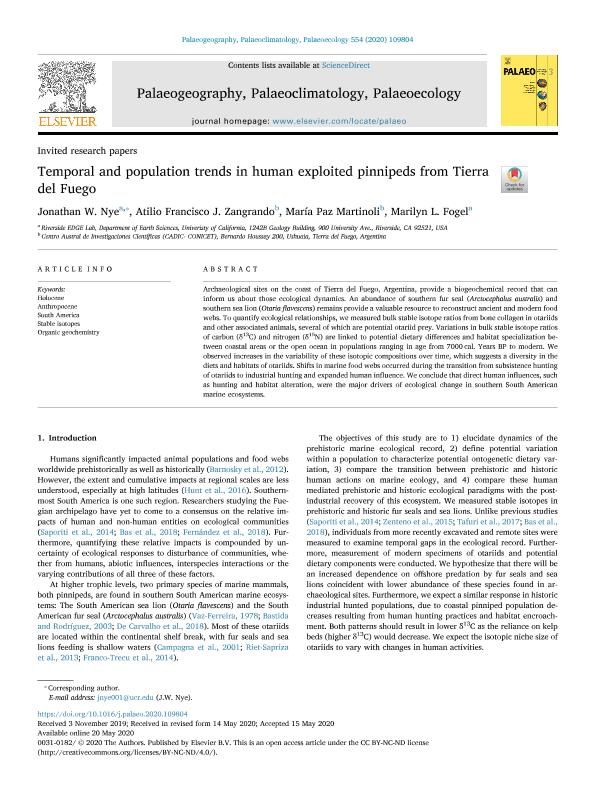Mostrar el registro sencillo del ítem
dc.contributor.author
Nye, Jonathan W.
dc.contributor.author
Zangrando, Atilio Francisco Javier

dc.contributor.author
Martinoli, Maria Paz

dc.contributor.author
Fogel, Marilyn

dc.date.available
2021-04-08T14:37:21Z
dc.date.issued
2020-09
dc.identifier.citation
Nye, Jonathan W.; Zangrando, Atilio Francisco Javier; Martinoli, Maria Paz; Fogel, Marilyn; Temporal and population trends in human exploited pinnipeds from Tierra del Fuego; Elsevier Science; Palaeogeography, Palaeoclimatology, Palaeoecology; 554; 9-2020; 1-20
dc.identifier.issn
0031-0182
dc.identifier.uri
http://hdl.handle.net/11336/129617
dc.description.abstract
Archaeological sites on the coast of Tierra del Fuego, Argentina, provide a biogeochemical record that can inform us about those ecological dynamics. An abundance of southern fur seal (Arctocephalus australis) and southern sea lion (Otaria flavescens) remains provide a valuable resource to reconstruct ancient and modern food webs. To quantify ecological relationships, we measured bulk stable isotope ratios from bone collagen in otariids and other associated animals, several of which are potential otariid prey. Variations in bulk stable isotope ratios of carbon (δ13C) and nitrogen (δ15N) are linked to potential dietary differences and habitat specialization between coastal areas or the open ocean in populations ranging in age from 7000 cal. Years BP to modern. We observed increases in the variability of these isotopic compositions over time, which suggests a diversity in the diets and habitats of otariids. Shifts in marine food webs occurred during the transition from subsistence hunting of otariids to industrial hunting and expanded human influence. We conclude that direct human influences, such as hunting and habitat alteration, were the major drivers of ecological change in southern South American marine ecosystems.
dc.format
application/pdf
dc.language.iso
eng
dc.publisher
Elsevier Science

dc.rights
info:eu-repo/semantics/openAccess
dc.rights.uri
https://creativecommons.org/licenses/by-nc-nd/2.5/ar/
dc.subject
ANTHROPOCENE
dc.subject
HOLOCENE
dc.subject
ORGANIC GEOCHEMISTRY
dc.subject
SOUTH AMERICA
dc.subject
STABLE ISOTOPES
dc.subject.classification
Arqueología

dc.subject.classification
Historia y Arqueología

dc.subject.classification
HUMANIDADES

dc.title
Temporal and population trends in human exploited pinnipeds from Tierra del Fuego
dc.type
info:eu-repo/semantics/article
dc.type
info:ar-repo/semantics/artículo
dc.type
info:eu-repo/semantics/publishedVersion
dc.date.updated
2021-02-17T20:56:29Z
dc.journal.volume
554
dc.journal.pagination
1-20
dc.journal.pais
Países Bajos

dc.journal.ciudad
Amsterdam
dc.description.fil
Fil: Nye, Jonathan W.. University of California; Estados Unidos
dc.description.fil
Fil: Zangrando, Atilio Francisco Javier. Consejo Nacional de Investigaciones Científicas y Técnicas. Centro Austral de Investigaciones Científicas; Argentina
dc.description.fil
Fil: Martinoli, Maria Paz. Consejo Nacional de Investigaciones Científicas y Técnicas. Centro Austral de Investigaciones Científicas; Argentina
dc.description.fil
Fil: Fogel, Marilyn. University of California; Estados Unidos
dc.journal.title
Palaeogeography, Palaeoclimatology, Palaeoecology

dc.relation.alternativeid
info:eu-repo/semantics/altIdentifier/url/https://linkinghub.elsevier.com/retrieve/pii/S0031018220302492
dc.relation.alternativeid
info:eu-repo/semantics/altIdentifier/doi/http://dx.doi.org/10.1016/j.palaeo.2020.109804
Archivos asociados
